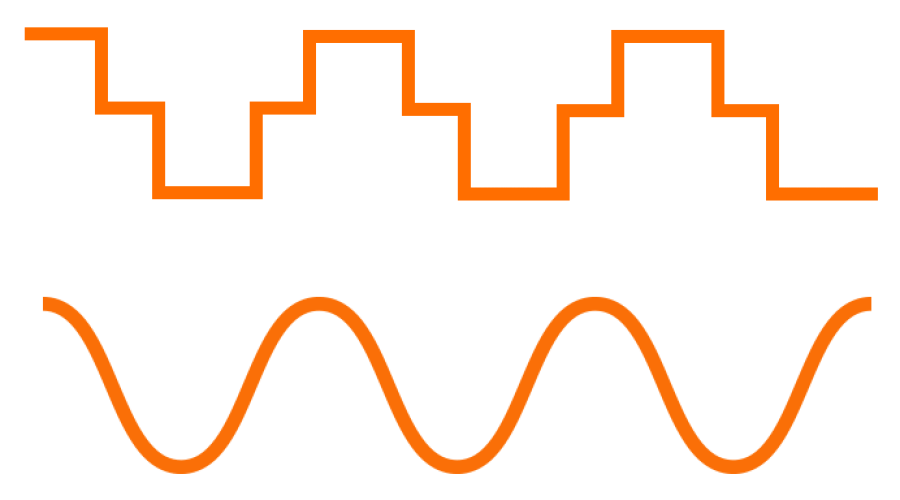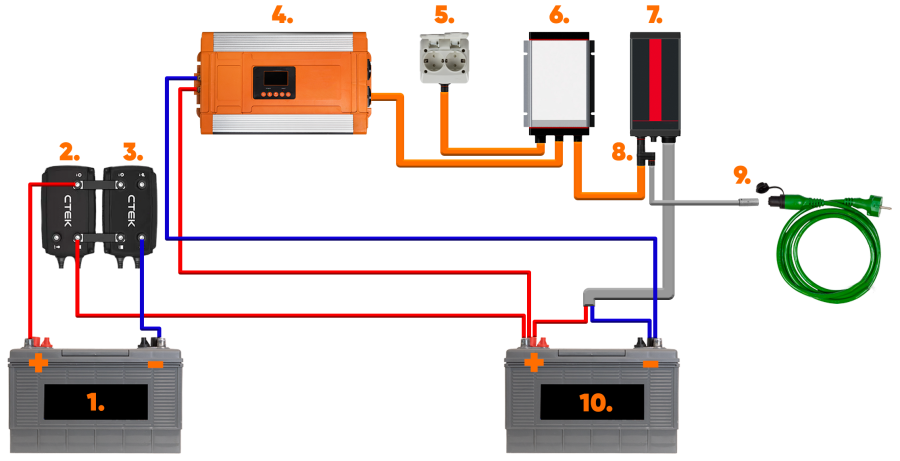WHAT IS AN INVERTER?
An inverter, converter or transformer are different names for the same product. The inverter's task is to convert the battery's voltage from either 12V or 24V direct current (DC) to 230V alternating current (AC) which is used in standard wall sockets. In Work System's standard range, you will find carefully selected 12V inverters that give you the possibility to use, for example, power tools, battery chargers, computer or microwave.
WHAT SIZE OF INVERTER DO I NEED?
An inverter can have different applications, so start by checking how much power the products you want to use requires. The information you need is usually listed on the product itself. If you want to run several things at the same time, you just add their wattages together. Keep in mind that the inverter should always be dimensioned a little higher than your calculated value. Partly because the products' rating data is not always 100%, but especially because the power is usually specified according to continuous power and not the current surge (peak power) that can occur for a shorter period at start-up.
Motorized products, such as compressors and angle grinders, tend to have high peak power. The same applies to microwave ovens and vacuum cleaners. At start-up, for example, a 1000W microwave draws twice as much, i.e. 2000W. An inverter always has a certain room for current surges and many models can handle a higher load for a shorter period. Here at Work System, we always state the continuous power in the product name and the peak power can be found under the inverter's specifications.
Find the right inverter with our calculator.HOW LONG CAN I USE THE INVERTER?
Here it is better to turn the question around: "How long do you intend to use the inverter?". Based on the desired operating time, the battery solution can then be dimensioned. In some cases the car's original battery is sufficient, but usually one or more extra batteries are required to ensure operation. It is also important to think about how the charging should be handled. It’s not uncommon for the distance driven to be too short in relation to the use of the inverter. An alternative is to leave the car running while you use the inverter, but we recommend that you supplement with solar panels on the roof or a battery charger that can be plugged in when the car is stationary during the night, for example.
Also keep in mind that the age and health of the battery may affect the operating time. The maximum voltage that the car manufacturer allows from the car's generator may impact the charging and operating time as well.
Find a recommended solution with our calculator.PURE OR MODIFIED SINE WAVE?
The short answer is that pure sine wave is preferred because it works for all types of electronics. Our standard wall sockets are operating on 230V alternating current with a frequency of 50 Hz, i.e. the current direction is reversed 50 times/second. A modified sine (also called square wave) inverter converts the current in several steps unlike a sine wave which makes the transition much smoother (see the illustration below).

There are electronics that are sensitive and need stable power-flow and will therefore not work or may be damaged by modified sine waves. Some examples are laptops, battery chargers and measuring instruments. Power efficiency and consumption can also be negatively affected. However, in simpler systems like mobile chargers, electric kettles and similar, modified sine waves can work well.
The conclusion is simple – pure sine wave inverters are superior and to make it easy to choose the right one, we only sell that type of inverter .
ARE THERE ANY REQUIREMENTS FOR INVERTERS?
Inverters and other electronic equipment must always be CE-marked and comply with the RoHS directive. When it comes to installation in vehicles, it is also required that the product is ECE R10 approved.
EXAMPLE OF INVERTER SOLUTION
Here follows a description and wiring diagram for a power solution for those who have many consumers and require a long operating time. During the working day, you get access to power for, for example, tools, a compressor or a microwave. While you drive, the battery is charged. When the working day is over, you connect the car to a wall outlet to charge the batteries. At the same time, you get continuous power in the car's wall socket, which during the night can power, for example, a heating fan to protect your frost-sensitive chemicals or charge tools. The next day just repeat the procedure.

COMPONENTS
1. Starter battery2. CTEK Smart pass
3. CTEK DC/DC
4. Inverter
5. DEFA Double plug-in socket
6. DEFA Autoswitch
7. DEFA Multicharger
8. DEFA Y joint
9. DEFA Connection kit
10. Extra battery
1. Select inverter
3. CTEK DC/DC
4. Inverter
5. DEFA Double plug-in socket
6. DEFA Autoswitch
7. DEFA Multicharger
8. DEFA Y joint
9. DEFA Connection kit
10. Extra battery
RECOMMENDED INVERTER CALCULATOR
In the calculator below, you can enter a few parameters to help you find the right inverter. Keep in mind that there are many aspects that can affect the inverter and its operation, therefore the calculation should only be seen as an indication.
CHECKLIST FOR ORDERING A COMPLETE INVERTER SOLUTION
1. Select inverter2. Check if an extra battery is needed
3. Add a battery monitor if needed. Especially important if the inverter is connected directly to the car's original battery. Many inverters have a built-in shutdown, but it is usually set too low (approx. 10.5V) which means that the remaining current isn’t enough to start the car. If you choose a larger inverter, an extra battery is always recommended.
4. Choose a cable kit intended for the inverter (the kits are available in different lengths)
5. If necessary, supplement with a charging solution such as a battery charger or solar panel.
CHECKLIST FOR INVERTER INSTALLATION
The right knowledge and caution are extremely important when working with electricity. Work System always recommends that you let our reliable and professional technicians perform the installation. Contact your nearest Work System facility for further assistance.
2. Check which cable dimension (cable area) is required - the easiest is to use the calculator below.
3. Do not connect the plus terminal to the inverter until the entire installation is complete.
4. Install a fuse on the plus cable max. 20 cm from the battery. The fuse must be permanently installed and the cable between it and the battery must not hang loose or risk damage.
5. Route the cables securely between inverter and battery, i.e. not loosely hanging and protected from sharp edges and impacts. The negative cable must not be grounded in the chassis at the inverter but at the battery's direct connection, not directly on the negative pole, as the car's battery shunt must measure the consumption.
6. Connect the protective earth to the car body to prevent the body from becoming live in the event of contact with a damaged 230V cable.
7. Install the fuse.
8. Start inverter without consumer connected.
9. Check that the batteries are fully charged.
10. Test the inverter by connecting consumers with maximum power and run according to the estimated operating time.
Yes - The battery voltage is too low. Charge the battery
CABLE DIMENSION CALCULATOR
Result
Recommended cable dimension: 0 mm²
TROUBLESHOOTING
When an inverter malfunctions, it is rarely the inverter itself that is faulty. Instead, the most common is a bad battery, bad cables or that connected products are too powerful in relation to the capacity of the inverter. Below you will find both simpler things you can try yourself and more advanced methods that may require our assistance.
INVERTER DISPLAYS ERROR CODE
Try to find what the error code means. If you can't find it - has the setup worked before?
Start the car, wait a few minutes and then restart the inverter. Is it working?
Yes - When the car is running, you get power from the car's generator. Therefore, it is very likely that the battery voltage is too low or the battery is bad. Do the following:
1. Try fully charging the battery.
2. Still not working? Perform a battery test.
No - Disconnect the products connected to the inverter and test again.
1. Is the inverter working now? Then it is most likely the product that has too high consumption or the battery is bad.
2. Test other equivalent products with lower consumption. Most likely, it isn’t the inverter that is broken, but the accessory products or alternatively the product that is plugged in. Start by troubleshooting the battery and the charging solution for it.
IT HAS NEVER WORKED WITH THIS SETUP
The inverter dies when you start the product
Start the car, wait a few minutes and restart the inverter. Is it working?
Yes - Insufficient voltage in the battery or under dimensioned connection cables.
No - The product may be too powerful for the inverter, i.e. the specification on the product does not match the actual consumption. Measure the product's consumption or test it on another inverter .
The inverter alerts and switches off after a while
Start the car, wait a few minutes and restart the inverter. Is it working?
Yes - The battery voltage is too low. Charge the battery
No - Let the inverter cool down and see if that helps. If the same problem occurs again, check that the cooling isn’t blocked or covered.
If the problem cannot be fixed, check the specifications for how long the inverter can handle the electric load.
If it has been ensured that the inverter always has the correct voltage and still doesn’t live up to the specifications – make a claim.
THE INVERT WON’T START
Do you have sufficient voltage (over 12.4V)?
Measure on the incoming plus/minus terminal to the inverter
Yes - More than 12.4V reaches the inverter, but it still does not start – make a claim.
No - The voltage is low (below 12.1V). Does it work if you start the car? Then it’s probably there is too little charge in the car or the battery is worn-out.
Voltage is missing - The problem occurs earlier in the chain. Do the following:
1. Check the fuse
2. Check if there is a battery monitor. What’s the voltage at it? If the voltage is close to the battery monitor's breakpoint, it may be the problem that causes the power to break.
3. Test the inverter on another fully charged battery with a fuse in between
3. Test the inverter on another fully charged battery with a fuse in between
4. If the inverter still does not work – make a claim and replace it.









